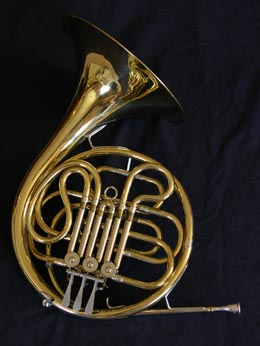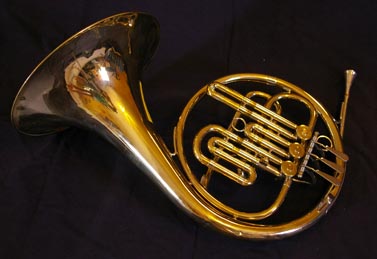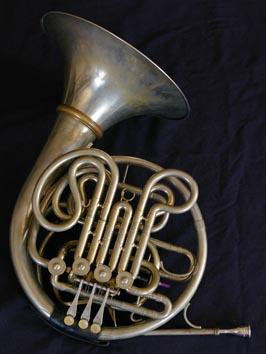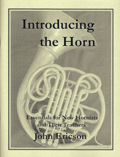
Horn Articles Online
Introducing the Horn
Welcome to the horn!

As I often tell new horn players, you have made a wise choice to play the horn. We have great music to perform and play a critical role in the middle of the brass section of bands and orchestras.
About instrument choices for beginners
There are two types of horn that are typically used by young hornists, the single F horn and the single B-flat horn. The single F horn is more common; one is illustrated to the right. It has three valves and is relatively inexpensive and lightweight.
It has been a longstanding tradition that young players start out on the single F horn. For those players reading this page who are playing on the single F horn at this time I tell you to stick with it but also to know that a single F is really only a starter instrument. At some point soon, certainly by high school, you will want to switch to the double horn. You will experience improved high range accuracy on the double horn, and it will be a much better instrument for the types of ensemble music you will see in more advanced groups in the coming years.
Some beginners start on another type
 of "single" instrument, the
single B-flat horn, illustrated next. You will note that the instrument looks very similar to the single F but the valve slides are shorter. This is because the instrument overall is shorter. A single F horn is around twelve feet long from mouthpiece to bell while a single B-flat is around nine feet. This shorter length translates into an instrument that is not only lighter but also easier to play accurately.
of "single" instrument, the
single B-flat horn, illustrated next. You will note that the instrument looks very similar to the single F but the valve slides are shorter. This is because the instrument overall is shorter. A single F horn is around twelve feet long from mouthpiece to bell while a single B-flat is around nine feet. This shorter length translates into an instrument that is not only lighter but also easier to play accurately.
One important note for directors: this instrument plays from the same music as used for F horn! Some of the fingerings are different but are exactly the same as the B-flat side of a double horn. See my fingering chart.
When I was first teaching I supported the use of the single F over the single B-flat for beginners. I am not totally against the use of the single F today but I am now also very open to the use of the single B-flat. My primary reason is there is more initial success for the new player on the single B-flat. It is easier to play; new hornists will be less likely to quit, something I hope they don't do! Also it could actually be used into high school if desired. For any pros that harbor doubts about the single B-flat, I would simply challenge them to try a back to back test of both instruments (single F/single B-flat) playing a basic solo such as the last movement of the third horn concerto of Mozart. There is no comparison, the single B-flat will be the clear
 winner between the two in terms of sound and articulations.
winner between the two in terms of sound and articulations.
The best solution to the problem is to start on the double horn if it is possible to hold one comfortably and if not to switch to one as soon as you can. The double horn has a bigger sound and is the standard among advanced players today. This is often the first type of horn used by players who switch to the horn later in junior high or in high school. For players coming to the horn later from other instruments it is certainly the place to start. For me it was my first instrument, I switched to the horn from the trumpet in ninth grade. A double horn is illustrated to the right. Note that the longer F horn valve slides are on top and the shorter B-flat horn valve slides are visible underneath. This is the "double" in double horn, the single F and single B-flat horns are combined into one instrument. The thumb valve is used to switch between the two sides of the instrument. A 3/4 size double horn is manufactured which is a great option for the younger beginner.
Mouthpieces?
Most recently I have been suggesting the Yamaha 30C4 for true beginners. The Schilke 30 is also a good choice. What you want is a mouthpiece that is not particularly large and easy to play on.
A key to starting out well on the horn
As you start out on the horn it is extremely important to listen to recordings of great horn playing, to have a clear model for what you hope to sound like in the future.
A horn at home, a horn at school
For younger students especially transporting a horn back and forth to school can be a problem. If possible it can be a great help to have a horn at school and a horn of the same general type at home.
Are you an orphan?
It is almost better to have no horn players than one lone horn player in a group. If you are that lone player, recruit a friend to play! Directors, do what you can to at least have a pair of players if not a full section in all your ensembles. The section will do much better with multiple players, and the better sound possible in any group with a full horn section is undeniable.
Books for players starting on or switching to the horn later
The other resource that would be great for any player starting on or switching to the horn would be a good introductory book on playing the horn.
The Art of French Horn Playing is a great, classic publication by Philip Farkas. However, it was published in 1956 and is getting
very dated, and for a younger student it also contains too much information.
Giving more hornists a good start is a goal of mine as a horn teacher. This goal led me to create my own publication for students starting on or switching to the horn, Introducing the Horn. It is my hope that this publication will serve to give many new hornists a good start on the horn and help educators give hornists a good start. There are a lot of unique aspects to playing the horn, aspects that ultimately make the horn very rewarding to play but do require some specialized teaching to understand well.
Introducing the Horn: Essentials for New Hornists and Their
 Teachers.
Teachers.
Covers the range of performance-related topics that are the most essential in giving a new hornist a good start. This updated edition is a great resource for beginners and for those converting to the horn, with information also of use to intermediate and advancing hornists. In addition, supplemental text is presented which is directed toward current and future instrumental music educators, and presents practical information that will serve to augment materials used in horn methods classes.
Available from Horn Notes Edition | Print version -- Kindle version
BONUS ARTICLE:
Fingering Chart for Single F, Double, and Single B-flat horns
At last! A fingering chart that clearly presents the fingerings for the three most popular types of horns for beginners, extracted from Introducing the Horn. PDF file.
A few frequently asked questions:
What mouthpiece would be best for a new horn player?
For a beginner a small to medium sized horn mouthpiece will give the best results. A mouthpiece that is deep and large bore with a thin rim will be the worst choice. Something like a Laskey 70G for a young student or 75G for a slightly older student would be my choice if I had to suggest one model.
What horn is best for a beginner?
As noted above, while young students were started traditionally on a single F, any type will work, single F, single B-flat, or double. If a student is big enough to hold a double horn this would be my first choice, and I would be open to the use of the single B-flat, it will give the young student a bit more initial success than a single F.
The 3/4 size double horn is also a great option, although it may be
difficult to find one to purchase or rent.
Why is the right hand in the bell?
The short answer would be tradition and tone. The horn is designed to be played with a hand
partially covering the opening of the bell, making the tone a bit more mellow and giving the high range better stability. I describe in some depth the proper placement of the right hand in my publication,
Introducing the Horn.
The other part of this question is why the right hand instead of the left? Before the invention of the valve in 1814 horn players did not have valves (!) and as most people are right handed they put the right hand in the bell where it was used it to open and close the bell to produce notes a half step lower than the open harmonics. When valves were added to the horn this playing position was not modified and the valves were activated with the left hand, the opposite of any other brass instrument.
The horn is a great instrument! Stick with it. I may be biased, but I think you have made a great choice to play the horn.
Return to Horn Articles Online